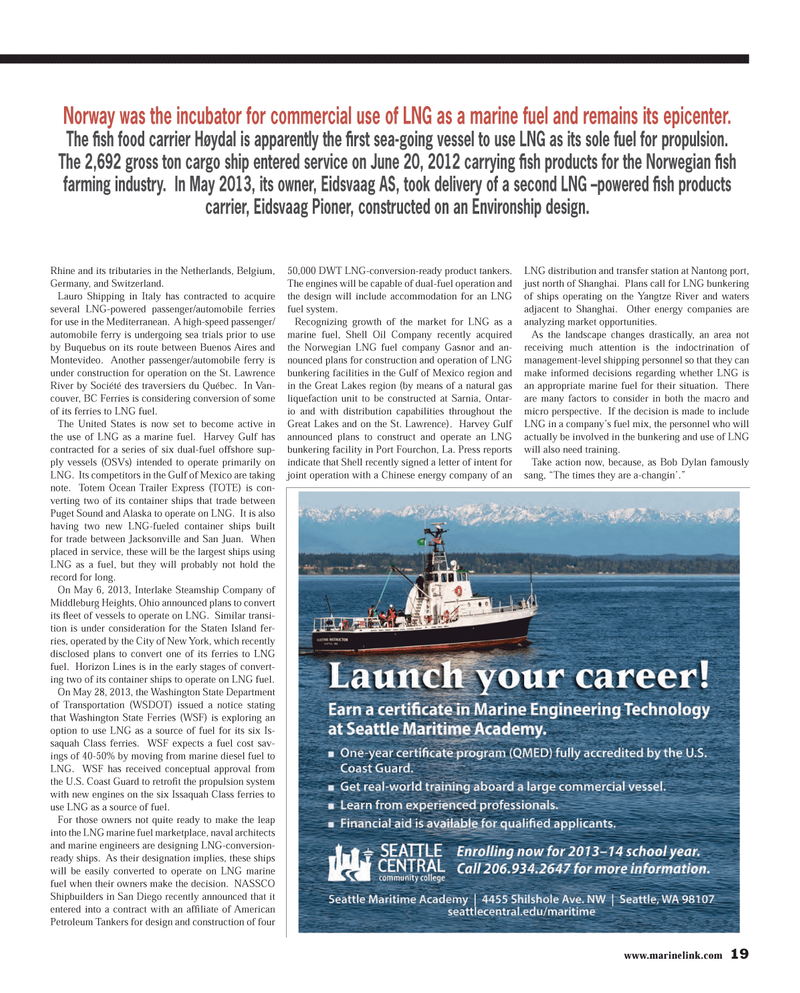
Page 19: of Maritime Reporter Magazine (July 2013)
Maritime Security Edition
Read this page in Pdf, Flash or Html5 edition of July 2013 Maritime Reporter Magazine
www.marinelink.com 19Rhine and its tributaries in the Netherlands, Belgium, Germany, and Switzerland. Lauro Shipping in Italy has contracted to acquire several LNG-powered passenger/automobile ferries for use in the Mediterranean. A high-speed passenger/ automobile ferry is undergoing sea trials prior to use by Buquebus on its route between Buenos Aires and Montevideo. Another passenger/automobile ferry is under construction for operation on the St. Lawrence River by Société des traversiers du Québec. In Van- couver, BC Ferries is considering conversion of some of its ferries to LNG fuel.The United States is now set to become active in the use of LNG as a marine fuel. Harvey Gulf has contracted for a series of six dual-fuel offshore sup- ply vessels (OSVs) intended to operate primarily on LNG. Its competitors in the Gulf of Mexico are taking note. Totem Ocean Trailer Express (TOTE) is con- verting two of its container ships that trade between Puget Sound and Alaska to operate on LNG. It is also having two new LNG-fueled container ships built for trade between Jacksonville and San Juan. When placed in service, these will be the largest ships using LNG as a fuel, but they will probably not hold the record for long. On May 6, 2013, Interlake Steamship Company of Middleburg Heights, Ohio announced plans to convert its ß eet of vessels to operate on LNG. Similar transi- tion is under consideration for the Staten Island fer- ries, operated by the City of New York, which recently disclosed plans to convert one of its ferries to LNG fuel. Horizon Lines is in the early stages of convert-ing two of its container ships to operate on LNG fuel.On May 28, 2013, the Washington State Department of Transportation (WSDOT) issued a notice stating that Washington State Ferries (WSF) is exploring an option to use LNG as a source of fuel for its six Is-saquah Class ferries. WSF expects a fuel cost sav- ings of 40-50% by moving from marine diesel fuel to LNG. WSF has received conceptual approval from the U.S. Coast Guard to retroÞ t the propulsion system with new engines on the six Issaquah Class ferries to use LNG as a source of fuel.For those owners not quite ready to make the leap into the LNG marine fuel marketplace, naval architects and marine engineers are designing LNG-conversion-ready ships. As their designation implies, these ships will be easily converted to operate on LNG marine fuel when their owners make the decision. NASSCO Shipbuilders in San Diego recently announced that it entered into a contract with an afÞ liate of American Petroleum Tankers for design and construction of four 50,000 DWT LNG-conversion-ready product tankers. The engines will be capable of dual-fuel operation and the design will include accommodation for an LNG fuel system.Recognizing growth of the market for LNG as a marine fuel, Shell Oil Company recently acquired the Norwegian LNG fuel company Gasnor and an-nounced plans for construction and operation of LNG bunkering facilities in the Gulf of Mexico region and in the Great Lakes region (by means of a natural gas liquefaction unit to be constructed at Sarnia, Ontar- io and with distribution capabilities throughout the Great Lakes and on the St. Lawrence). Harvey Gulf announced plans to construct and operate an LNG bunkering facility in Port Fourchon, La. Press reports indicate that Shell recently signed a letter of intent for joint operation with a Chinese energy company of an LNG distribution and transfer station at Nantong port, just north of Shanghai. Plans call for LNG bunkering of ships operating on the Yangtze River and waters adjacent to Shanghai. Other energy companies are analyzing market opportunities.As the landscape changes drastically, an area not receiving much attention is the indoctrination of management-level shipping personnel so that they can make informed decisions regarding whether LNG is an appropriate marine fuel for their situation. There are many factors to consider in both the macro and micro perspective. If the decision is made to include LNG in a company?s fuel mix, the personnel who will actually be involved in the bunkering and use of LNG will also need training.Take action now, because, as Bob Dylan famously sang, ?The times they are a-changin?.?Norway was the incubator for commercial use of LNG as a marine fuel and remains its epicenter. The Þ sh food carrier H¿ydal is apparently the Þ rst sea-going vessel to use LNG as its sole fuel for propulsion. The 2,692 gross ton cargo ship entered service on June 20, 2012 carrying Þ sh products for the Norwegian Þ sh farming industry. In May 2013, its owner, Eidsvaag AS, took delivery of a second LNG Ðpowered Þ sh products carrier, Eidsvaag Pioner, constructed on an Environship design. MR #7 (18-25).indd 19MR #7 (18-25).indd 197/1/2013 9:05:41 AM7/1/2013 9:05:41 AM

 18
18

 20
20
